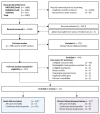Bioimpedance Indices of Fluid Overload and Cardiorenal Outcomes in Heart Failure and Chronic Kidney Disease: a Systematic Review
- PMID: 36038013
- PMCID: PMC7613800
- DOI: 10.1016/j.cardfail.2022.08.005
Bioimpedance Indices of Fluid Overload and Cardiorenal Outcomes in Heart Failure and Chronic Kidney Disease: a Systematic Review
Abstract
Background: Bioimpedance-based estimates of fluid overload have been widely studied and systematically reviewed in populations of those undergoing dialysis, but data from populations with heart failure or nondialysis chronic kidney disease (CKD) have not.
Methods and results: We conducted a systematic review of studies using whole-body bioimpedance from populations with heart failure and nondialysis CKD that reported associations with mortality, cardiovascular outcomes and/or CKD progression. We searched MEDLINE, Embase databases and the Cochrane CENTRAL registry from inception to March 14, 2022. We identified 31 eligible studies: 20 heart failure and 11 CKD cohorts, with 2 studies including over 1000 participants. A wide range of various bioimpedance methods were used across the studies (heart failure: 8 parameters; CKD: 6). Studies generally reported positive associations, but between-study differences in bioimpedance methods, fluid overload exposure definitions and modeling approaches precluded meta-analysis. The largest identified study was in nondialysis CKD (Chronic Renal Insufficiency Cohort, 3751 participants), which reported adjusted hazard ratios (95% confidence intervals) for phase angle < 5.59 vs ≥ 6.4 of 2.02 (1.67-2.43) for all-cause mortality; 1.80 (1.46-2.23) for heart failure events; and 1.78 (1.56-2.04) for CKD progression.
Conclusions: Bioimpedance indices of fluid overload are associated with risk of important cardiorenal outcomes in heart failure and CKD. Facilitation of more widespread use of bioimpedance requires consensus on the optimum device, standardized analytical methods and larger studies, including more detailed characterization of cardiac and renal phenotypes.
Keywords: Bioimpedance; chronic kidney disease; fluid overload; heart failure.
Copyright © 2022 The Author(s). Published by Elsevier Inc. All rights reserved.
Figures


Similar articles
-
Multiple-frequency bioimpedance devices for fluid management in people with chronic kidney disease receiving dialysis: a systematic review and economic evaluation.Health Technol Assess. 2018 Jan;22(1):1-138. doi: 10.3310/hta22010. Health Technol Assess. 2018. PMID: 29298736 Free PMC article.
-
Antiplatelet agents for chronic kidney disease.Cochrane Database Syst Rev. 2022 Feb 28;2(2):CD008834. doi: 10.1002/14651858.CD008834.pub4. Cochrane Database Syst Rev. 2022. PMID: 35224730 Free PMC article.
-
Comparison of cellulose, modified cellulose and synthetic membranes in the haemodialysis of patients with end-stage renal disease.Cochrane Database Syst Rev. 2001;(3):CD003234. doi: 10.1002/14651858.CD003234. Cochrane Database Syst Rev. 2001. Update in: Cochrane Database Syst Rev. 2005 Jul 20;(3):CD003234. doi: 10.1002/14651858.CD003234.pub2. PMID: 11687058 Updated.
-
Beta-blockers in patients without heart failure after myocardial infarction.Cochrane Database Syst Rev. 2021 Nov 5;11(11):CD012565. doi: 10.1002/14651858.CD012565.pub2. Cochrane Database Syst Rev. 2021. PMID: 34739733 Free PMC article.
-
Dexrazoxane for preventing or reducing cardiotoxicity in adults and children with cancer receiving anthracyclines.Cochrane Database Syst Rev. 2022 Sep 27;9(9):CD014638. doi: 10.1002/14651858.CD014638.pub2. Cochrane Database Syst Rev. 2022. PMID: 36162822 Free PMC article.
Cited by
-
Associations of Abnormal Fluid Status, Plasma Sodium Disorders, and Low Dialysate Sodium with Mortality in Patients on Hemodialysis.Clin J Am Soc Nephrol. 2024 Nov 1;19(11):1444-1452. doi: 10.2215/CJN.0000000000000552. Epub 2024 Sep 10. Clin J Am Soc Nephrol. 2024. PMID: 39514693
-
Effects of Empagliflozin on Fluid Overload, Weight, and Blood Pressure in CKD.J Am Soc Nephrol. 2024 Feb 1;35(2):202-215. doi: 10.1681/ASN.0000000000000271. Epub 2023 Dec 12. J Am Soc Nephrol. 2024. PMID: 38082486 Free PMC article. Clinical Trial.
-
Association of tea consumption with all-cause/cardiovascular disease mortality in the chronic kidney disease population: an assessment of participation in the national cohort.Ren Fail. 2025 Dec;47(1):2449578. doi: 10.1080/0886022X.2025.2449578. Epub 2025 Jan 13. Ren Fail. 2025. PMID: 39806767 Free PMC article.
-
Early repeat hospitalization for fluid overload in individuals with cardiovascular disease and risks: a retrospective cohort study.Int Urol Nephrol. 2024 Mar;56(3):1083-1091. doi: 10.1007/s11255-023-03747-2. Epub 2023 Aug 24. Int Urol Nephrol. 2024. PMID: 37615843
-
Prognostic value of serum IGF-1, Gal-3, and PTX-3 levels in elderly patients with chronic heart failure.Am J Transl Res. 2024 Apr 15;16(4):1393-1400. doi: 10.62347/ZOMD7815. eCollection 2024. Am J Transl Res. 2024. PMID: 38715822 Free PMC article.
References
-
- House AA, Wanner C, Sarnak MJ, Piña IL, McIntyre CW, Komenda P, et al. Heart failure in chronic kidney disease: conclusions from a Kidney Disease: Improving Global Outcomes (KDIGO) Controversies Conference. Kidney Int. 2019;95:1304–17. - PubMed
-
- Foley RN. Clinical epidemiology of cardiac disease in dialysis patients: left ventricular hypertrophy, ischemic heart disease, and cardiac failure. Semin Dial. 2003;16:111–7. - PubMed
-
- Tuegel C, Bansal N. Heart failure in patients with kidney disease. Heart. 2017;103:1848–53. - PubMed
-
- Fonarow GC, Heywood JT. The confounding issue of comorbid renal insufficiency. Am J Med. 2006;119(12 Suppl 1):S17–25. - PubMed

